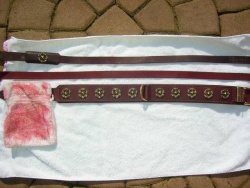Difference between revisions of "Latigo leather"
(Created page with "<p align=center> 300px </p> Latigo leather is cowhide leather that is combination tanned. First it is chrome tanned, then it is vegetable tan...") |
|||
| Line 4: | Line 4: | ||
| − | Latigo leather is | + | '''Latigo leather''' (Spanisch ''látigo'' = the [[Leather whips|whip]]) is a firm, durable and [[aniline leather|porous]] [[smooth leather|smooth]] [[cow leather]], which is particularly common in horse riding. It is used for [[leather saddle|saddle seats]] and [[Leather straps|straps]]. It can be [[vegetable]] or [[Chrome tanned|chromium-tanned]] and is characterized by the fact that it is [[Oils & fats in the leather industry|oiled or waxed]] after [[leather production|tanning]] and [[leather colour|dyeing]]. This makes a [[Haptic evaluation of leather surfaces|soft grip]], which makes latigo leather also popular for [[Dog leash - Dog collar|dog leashes]]. |
| − | Latigo is | + | Latigo leather is mostly manufactured in black, brown tones and darker red shades. Brighter colors are seldom. White is archieved by bleaching prior to [[leather colour|dying]] and applying a [[finish|pigment based finis]]. |
| − | In Western saddlery latigos are the name | + | In Western saddlery, latigos are the name of the straps securing the cinches to the saddle rigging. They are named for the latigo leather which is used to manufacture them. |
| − | + | The disadvantage of latigo leather is that it can lead to [[Colour separation of leather|discolouration on clothing]], skin and dog fur, as the dye is sometimes not abrasion resistant enough because of the [[aniline leather|porosity]] and strong [[Oils & fats in the leather industry|fatliquoring]]. This can be tested. Moisten a white cloth and rub the leather ten times. Feast, but not by force. Depending on the discoloration of the flap, the sensitivity is aceptable or not. | |
| − | + | ||
| − | + | ||
| − | + | ||
| − | + | ||
| − | + | ||
| Line 22: | Line 17: | ||
</p> | </p> | ||
<p align=center> | <p align=center> | ||
| − | ''[[ | + | ''[[Colour separation of leather|Discoloration]] due to friction with a dog collar made of latigo leather.''<br></p> |
<p> </p> | <p> </p> | ||
| Line 28: | Line 23: | ||
| − | == | + | ==Additional informationn== |
| − | * [[ | + | * [[Dog leash - Dog collar]] |
Revision as of 21:20, 20 December 2016
Latigo leather (Spanisch látigo = the whip) is a firm, durable and porous smooth cow leather, which is particularly common in horse riding. It is used for saddle seats and straps. It can be vegetable or chromium-tanned and is characterized by the fact that it is oiled or waxed after tanning and dyeing. This makes a soft grip, which makes latigo leather also popular for dog leashes.
Latigo leather is mostly manufactured in black, brown tones and darker red shades. Brighter colors are seldom. White is archieved by bleaching prior to dying and applying a pigment based finis.
In Western saddlery, latigos are the name of the straps securing the cinches to the saddle rigging. They are named for the latigo leather which is used to manufacture them.
The disadvantage of latigo leather is that it can lead to discolouration on clothing, skin and dog fur, as the dye is sometimes not abrasion resistant enough because of the porosity and strong fatliquoring. This can be tested. Moisten a white cloth and rub the leather ten times. Feast, but not by force. Depending on the discoloration of the flap, the sensitivity is aceptable or not.
Discoloration due to friction with a dog collar made of latigo leather.
Additional informationn









 a kotori web solution
a kotori web solution